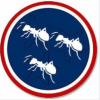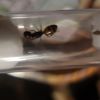1. Location of collection (ie: park/area, city/town, state/province, country). Downtown knoxville tn usa
2. Date of collection (more important for ID's of queens). 6/7/2022
3. Habitat of collection (ie: desert scrub, oak forest, riparian, etc.). Inside small log fragment
4. Length (to the nearest millimeter or 1/16th of an inch.) Millimeters is preferred. Length is measured from the tip of the head to the tip of the gaster, excluding antennae, legs and stingers. Do not estimate, use a ruler! No matter how good you think you are at guessing the length of something, it's amazing how far off you can be sometimes. About 1cm
5. Coloration, hue, pattern and texture (ie: dark redish-orange head, velvet-like gaster, translucent, hairy/bald, shiny/dull, etc.). Be as specific as possible, and you can use the diagram below if you need it. Red with dark circles on abdomen
6. Distinguishing characteristics (ie: one petiole node/two petiole nodes, length and orientation of any spines or bumps on the thorax or waist, head shape, eye size, shape of mandibles, number of antennal segments, etc.) Color stripe pattern
7. Anything else distinctive (ie: odor, behavior, characteristics relative to others in the colony, etc.). A
8. Nest description (if you can find the nest, and you're sure it belongs to the ant you collected) (ie: rotted log, volcano-shaped mound of coarse gavel 10cm in diameter, etc.). In wood
9. Nuptial flight time and date (if you witnessed the ant or it's colony having a nuptial flight or caught an alate you are confident was flying that day or time)
10 . Post the clearest pictures possible of the top, side, and face of the ant in question, and if possible, their nest and the habitat they were collected in















